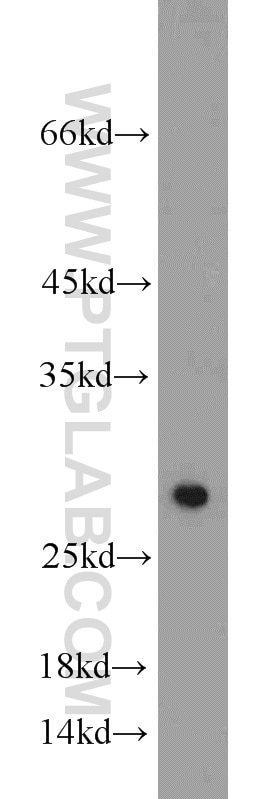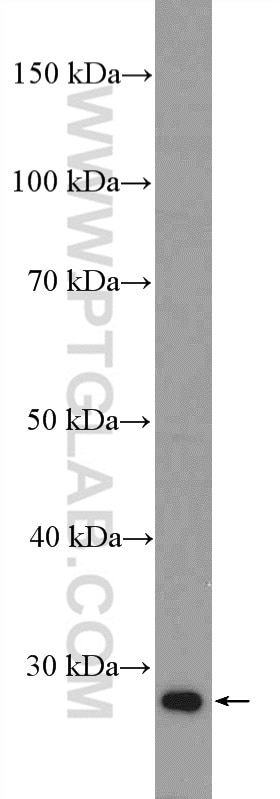Validation Data Gallery
Tested Applications
| Positive WB detected in | HT-29 cells, mouse heart tissue, human spleen tissue, mouse kidney tissue, mouse skeletal muscle tissue, rat heart tissue, HEK-293 cells, HepG2 cells, mouse liver tissue, rat liver tissue |
| Positive IP detected in | HT-29 cells |
| Positive IHC detected in | human stomach tissue, human intrahepatic cholangiocarcinoma tissue Note: suggested antigen retrieval with TE buffer pH 9.0; (*) Alternatively, antigen retrieval may be performed with citrate buffer pH 6.0 |
Recommended dilution
| Application | Dilution |
|---|---|
| Western Blot (WB) | WB : 1:1000-1:8000 |
| Immunoprecipitation (IP) | IP : 0.5-4.0 ug for 1.0-3.0 mg of total protein lysate |
| Immunohistochemistry (IHC) | IHC : 1:200-1:800 |
| It is recommended that this reagent should be titrated in each testing system to obtain optimal results. | |
| Sample-dependent, Check data in validation data gallery. | |
Published Applications
| KD/KO | See 19 publications below |
| WB | See 125 publications below |
| IF | See 1 publications below |
| IP | See 2 publications below |
| CoIP | See 4 publications below |
Product Information
10099-1-AP targets SIRT3 in WB, IHC, IF, IP, CoIP, ELISA applications and shows reactivity with human, mouse, rat samples.
| Tested Reactivity | human, mouse, rat |
| Cited Reactivity | human, mouse, rat, pig, bovine, goat |
| Host / Isotype | Rabbit / IgG |
| Class | Polyclonal |
| Type | Antibody |
| Immunogen | SIRT3 fusion protein Ag0148 相同性解析による交差性が予測される生物種 |
| Full Name | sirtuin (silent mating type information regulation 2 homolog) 3 (S. cerevisiae) |
| Calculated molecular weight | 44 kDa |
| Observed molecular weight | 28 kDa |
| GenBank accession number | BC001042 |
| Gene Symbol | SIRT3 |
| Gene ID (NCBI) | 23410 |
| RRID | AB_2239240 |
| Conjugate | Unconjugated |
| Form | Liquid |
| Purification Method | Antigen affinity purification |
| UNIPROT ID | Q9NTG7 |
| Storage Buffer | PBS with 0.02% sodium azide and 50% glycerol , pH 7.3 |
| Storage Conditions | Store at -20°C. Stable for one year after shipment. Aliquoting is unnecessary for -20oC storage. |
Background Information
Sirtuins are NAD+-dependent histone/protein deacetylases (HDAC) and SIRT3 is the only sirtuin whose increased expression has been shown to correlate with an extended life span in humans. It is localized in the mitochondrial matrix, where it regulates the acetylation levels of metabolic enzymes, including acetyl coenzyme A synthetase 2. SIRT3 is stress-responsive and its increased expression protects myocytes from genotoxic and oxidative stress-mediated cell death. full-length hSIRT3 (44 kDa) is an inert protein and that it is activated inside the mitochondria following deletion of 142 amino acids of the N-terminal segment. This processed form of SIRT3 is approximately 28 kDa and possesses deacetylase activity. The full SIRT3 is a 44 kDa protein and is processed by mitochondrial processing peptidase (MPP) to give a 28 kDa product.
Protocols
| Product Specific Protocols | |
|---|---|
| WB protocol for SIRT3 antibody 10099-1-AP | Download protocol |
| IHC protocol for SIRT3 antibody 10099-1-AP | Download protocol |
| IP protocol for SIRT3 antibody 10099-1-AP | Download protocol |
| Standard Protocols | |
|---|---|
| Click here to view our Standard Protocols |
Publications
| Species | Application | Title |
|---|---|---|
Cell Metab Elevation of JAML Promotes Diabetic Kidney Disease by Modulating Podocyte Lipid Metabolism. | ||
Nat Commun Sirt6 deficiency exacerbates podocyte injury and proteinuria through targeting Notch signaling. | ||
Nat Commun Cordycepin prevents radiation ulcer by inhibiting cell senescence via NRF2 and AMPK in rodents. | ||
Redox Biol Adiponectin/AdiopR1 signaling prevents mitochondrial dysfunction and oxidative injury after traumatic brain injury in a SIRT3 dependent manner. | ||
Cell Death Dis Metformin improves HPRT1-targeted purine metabolism and repairs NR4A1-mediated autophagic flux by modulating FoxO1 nucleocytoplasmic shuttling to treat postmenopausal osteoporosis | ||
J Pharm Anal Cornus officinalis with high pressure wine steaming enhanced anti-hepatic fibrosis: Possible through SIRT3-AMPK axis |









